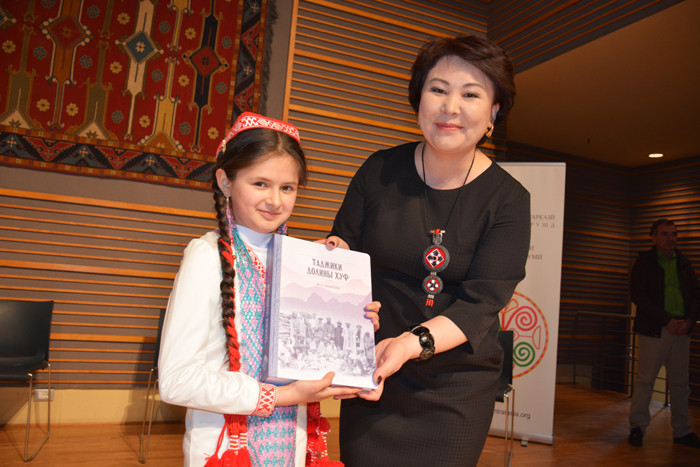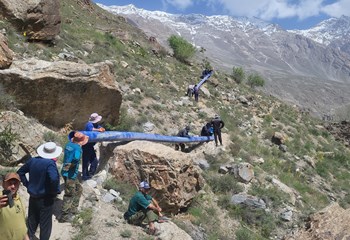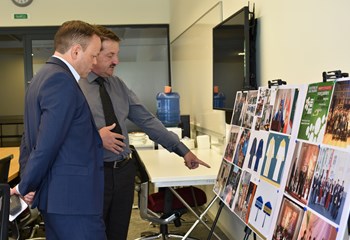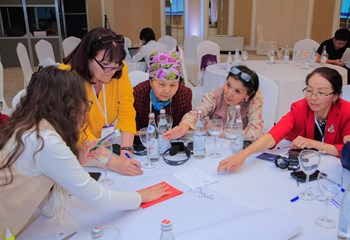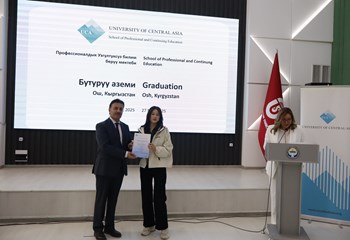
UCA Book Launch: Three New Books on Cultural Heritage of Central Asia
Dr. Bahriniso Kobilova (left), from the Institute of History, Archeology and Ethnography of the Academy of Science of the Republic of Tajikistan, and Kurbon Alamshoev (right), receive the new edition of the Tajiks of Huf Valley publication.
Kurbon Alamshoev travelled a long distance from the Gorno-Badakhshan Autonomous Oblast to Dushanbe, a fifteen-hour car ride, all to see a book. “I was very excited to read news about the University of Central Asia’s book launch, and to see in the listed books, a new edition of ‘Tajiks of Huf Valley’ by a famous orientalist Mikhail Andreev. This book has long been regarded as a library rarity, and many of us feared it might soon disappear altogether,” said Alamshoev. “As a journalist and researcher, who has been studying Andreev's archives for years, I can appreciate the immense amount of work it took to republish this book. It demonstrates a great commitment by UCA in the restoration of valuable ethnographic materials.”
On February 29th 2020, the University of Central Asia’s (UCA) Cultural Heritage and Humanities Unit (CHHU) held a book launch, presenting three new releases in its Cultural Heritage Book Series. It was held at the Ismaili Centre in Dushanbe (Tajikistan), and gathered over 200 attendees from the academic community, international organisations, as well as state officials.
About the Books
 “Andrei Evlampievich Madji: Half a Century of Research in Central Asia”, is written by Victor Dubovitskii, historian, publicist and writer. The book covers the life and work of Andrei Maji, an orientalist who made a great contribution to world science. This bibliographic work contains unique archival documents, and previously unknown works of the scientist, reflecting the most important events of Russia, and Central Asia. The valuable materials featured in the book may be interesting for scientists, researchers, and people interested in the development of science and the history of Tajikistan, Uzbekistan, Kyrgyzstan, and Afghanistan in the late 19th and early 20th centuries.
“Andrei Evlampievich Madji: Half a Century of Research in Central Asia”, is written by Victor Dubovitskii, historian, publicist and writer. The book covers the life and work of Andrei Maji, an orientalist who made a great contribution to world science. This bibliographic work contains unique archival documents, and previously unknown works of the scientist, reflecting the most important events of Russia, and Central Asia. The valuable materials featured in the book may be interesting for scientists, researchers, and people interested in the development of science and the history of Tajikistan, Uzbekistan, Kyrgyzstan, and Afghanistan in the late 19th and early 20th centuries.
 “Architectural Odyssey. ‘Safarnama’ by Nasir Khusraw,” was written by Munavar Mamadnazarov, and introduces the reader to medieval Islamic architecture. The author draws on medieval written sources, studies and the book “Safarnama” (Travel Book) by Nasir Khusraw (Persian-Tajik poet, philosopher, traveler and preacher who lived in the 11th century). The book features religious shrines of the Islamic East, buildings of ancient Egypt, Rome and Byzantine, Badakhshan's architectural environment, more than 300 photographs, pictures and drawings, allowing the reader to make an exciting and insightful journey into the past. The book is intended for architects, art historians, orientalists, ethnographers, as well as people interested in Islamic culture.
“Architectural Odyssey. ‘Safarnama’ by Nasir Khusraw,” was written by Munavar Mamadnazarov, and introduces the reader to medieval Islamic architecture. The author draws on medieval written sources, studies and the book “Safarnama” (Travel Book) by Nasir Khusraw (Persian-Tajik poet, philosopher, traveler and preacher who lived in the 11th century). The book features religious shrines of the Islamic East, buildings of ancient Egypt, Rome and Byzantine, Badakhshan's architectural environment, more than 300 photographs, pictures and drawings, allowing the reader to make an exciting and insightful journey into the past. The book is intended for architects, art historians, orientalists, ethnographers, as well as people interested in Islamic culture.
 “The Tajiks of the Khuf Valley,” by Mikhail Stepanovich Andreev (1873-1948), a renown ethnographer, orientalist and scholar of Central Asian culture. This is practically the only available ethnographic research on the everyday life and culture of Tajiks from the upper streams of the Amu-Darya River. It remains a relevant source of anthropological data on the lifestyle of sedentary peoples in Central Asia.
“The Tajiks of the Khuf Valley,” by Mikhail Stepanovich Andreev (1873-1948), a renown ethnographer, orientalist and scholar of Central Asian culture. This is practically the only available ethnographic research on the everyday life and culture of Tajiks from the upper streams of the Amu-Darya River. It remains a relevant source of anthropological data on the lifestyle of sedentary peoples in Central Asia.

